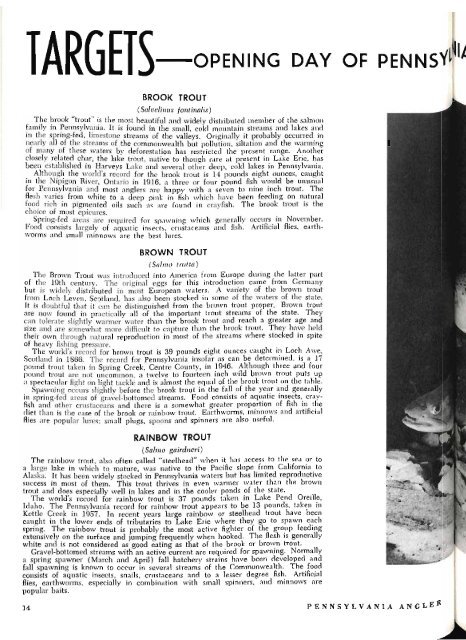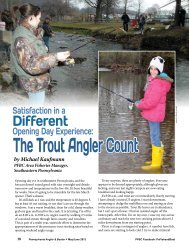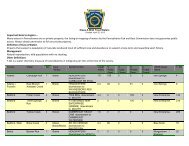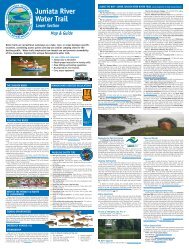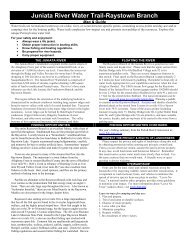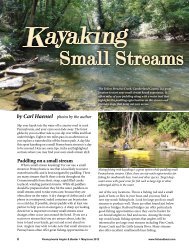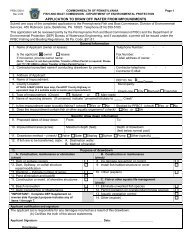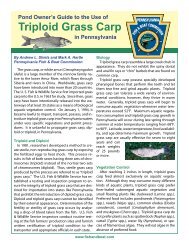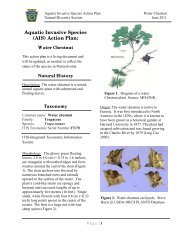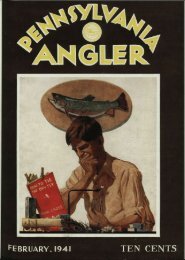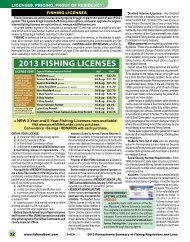m&M: - Pennsylvania Fish and Boat Commission
m&M: - Pennsylvania Fish and Boat Commission
m&M: - Pennsylvania Fish and Boat Commission
You also want an ePaper? Increase the reach of your titles
YUMPU automatically turns print PDFs into web optimized ePapers that Google loves.
TARGETS<br />
BROOK TROUT<br />
(Salvelin us fontinalis)<br />
The brook "trout" is the most beautiful <strong>and</strong> widely distributed member of the salmon<br />
family in <strong>Pennsylvania</strong>. It is found in the small, cold mountain streams <strong>and</strong> lakes <strong>and</strong><br />
in the spring-fed, limestone streams of the valleys. Originally it probably occurred in<br />
nearly all of the streams of the commonwealth but pollution, siltation <strong>and</strong> the warming<br />
of many of these waters by deforestation has restricted the present range. Another<br />
closely related char, the lake trout, native to though rare at present in Lake Erie, has<br />
been established in Harveys Lake <strong>and</strong> several other deep, cold lakes in <strong>Pennsylvania</strong>.<br />
Although the world's record for the brook trout is 14 pounds eight ounces, caught<br />
in the Nipigon River, Ontario in 1916, a three or four pound fish would be unusual<br />
for <strong>Pennsylvania</strong> <strong>and</strong> most anglers are happy with a seven to nine inch trout. The<br />
flesh varies from white to a deep pink in fish which have been feeding on natural<br />
food rich in pigmented oils such as are found in crayfish. The brook trout is the<br />
choice of most epicures.<br />
Spring-fed areas are required for spawning which generally occurs in November.<br />
Food consists largely of aquatic insects, crustaceans <strong>and</strong> fish. Artificial flies, earthworms<br />
<strong>and</strong> small minnows are the best lures.<br />
BROWN TROUT<br />
(Salmo trutta)<br />
The Brown Trout was introduced into America from Europe during the latter part<br />
of the 19th century. The original eggs for this introduction came from Germany<br />
but is widely distributed in most European waters. A variety of the brown trout<br />
from Loch Leven, Scotl<strong>and</strong>, has also been stocked in some of the waters of the state.<br />
It is doubtful that it can be distinguished from the brown trout proper. Brown trout<br />
are now found in practically all of the important trout streams of the state. They<br />
can tolerate slightly warmer water than the brook trout <strong>and</strong> reach a greater age <strong>and</strong><br />
size <strong>and</strong> are somewhat more difficult to capture than the brook trout. They have held<br />
their own through natural reproduction in most of the streams where stocked in spite<br />
of heavy fishing pressure.<br />
The world's record for brown trout is 39 pounds eight ounces caught in Loch Awe,<br />
Scotl<strong>and</strong> in 1866. The record for <strong>Pennsylvania</strong> insofar as can be determined, is a 17<br />
pound trout taken in Spring Creek, Centre County, in 1946. Although three <strong>and</strong> four<br />
pound trout are not uncommon, a twelve to fourteen inch wild brown trout puts up<br />
a spectacular fight on light tackle <strong>and</strong> is almost the equal of the brook trout on the table.<br />
Spawning occurs slightly before the brook trout in the fall of the year <strong>and</strong> generally<br />
in spring-fed areas of gravel-bottomed streams. Food consists of aquatic insects, crayfish<br />
<strong>and</strong> other crustaceans <strong>and</strong> there is a somewhat greater proportion of fish in the<br />
diet than is the case of the brook or rainbow trout. Earthworms, minnows <strong>and</strong> artificial<br />
flies are popular lures; small plugs, spoons <strong>and</strong> spinners are also useful.<br />
RAINBOW TROUT<br />
(Salmo gairdneri)<br />
The rainbow trout, also often called "steelhead" when it has access to the sea or to<br />
a large lake in which to mature, was native to the Pacific slope from California to<br />
Alaska. It has been widely stocked in <strong>Pennsylvania</strong> waters but has limited reproductive<br />
success in most of them. This trout thrives in even warmer water than the brown<br />
trout <strong>and</strong> does especially well in lakes <strong>and</strong> in the cooler ponds of the state.<br />
The world's record for rainbow trout is 37 pounds taken in Lake Pend Oreille,<br />
Idaho. The <strong>Pennsylvania</strong> record for rainbow trout appears to be 13 pounds, taken in<br />
Kettle Creek in 1957. In recent years large rainbow or steelhead trout have been<br />
caught in the lower ends of tributaries to Lake Erie where they go to spawn each<br />
spring. The rainbow trout is probably the most active fighter of the group feeding<br />
extensively on the surface <strong>and</strong> jumping frequently when hooked. The flesh is generally<br />
white <strong>and</strong> is not considered as good eating as that of the brook or brown trout.<br />
Gravel-bottomed streams with an active current are required for spawning. Normally<br />
a spring spawner (March <strong>and</strong> April) fall hatchery strains have been developed <strong>and</strong><br />
fall spawning is known to occur in several streams of the Commonwealth. The food<br />
consists of aquatic insects, snails, crustaceans <strong>and</strong> to a lesser degree fish. Artificial<br />
flies, earthworms, especially in combination with small spinners, <strong>and</strong> minnows are<br />
popular baits.<br />
OPENING DAY OF PENNS yi'l/<br />
14 PENNSYLVANIA ANG LEP<br />
*•&*<br />
s


